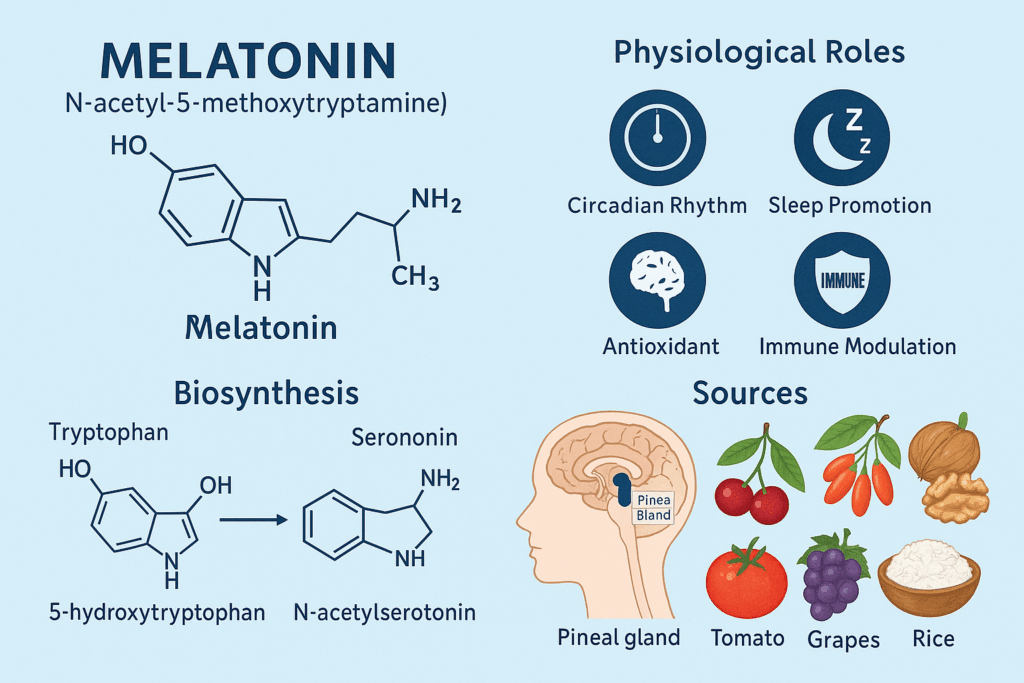Natural Melatonin: The Body’s Endogenous Timekeeper and Antioxidant
Abstract:
Melatonin is a naturally occurring indoleamine primarily synthesized in the pineal gland, with significant roles in regulating circadian rhythms, promoting sleep, modulating immune responses, and functioning as a powerful antioxidant. This article provides an updated scientific overview of natural melatonin: its biosynthesis, physiological effects, regulatory mechanisms, and emerging therapeutic potential in sleep disorders, neurodegeneration, and cancer.
1. Introduction
Melatonin (N-acetyl-5-methoxytryptamine) is a hormone found in animals, plants, fungi, and bacteria. In humans and most mammals, it is synthesized mainly in the pineal gland, where it serves as the primary signal of darkness to the body, regulating the sleep-wake cycle. Beyond circadian regulation, melatonin exerts a wide range of systemic effects, many of which are still under investigation.
2. Biosynthesis of Natural Melatonin
Melatonin biosynthesis begins with the essential amino acid tryptophan, which undergoes hydroxylation and decarboxylation to form serotonin. The pathway proceeds as follows:
- Tryptophan → 5-hydroxytryptophan → Serotonin
- Serotonin → N-acetylserotonin → Melatonin
This process is tightly regulated by light exposure, with production peaking at night. The rate-limiting enzyme in this cascade, arylalkylamine N-acetyltransferase (AANAT), is highly sensitive to neural input from the suprachiasmatic nucleus (SCN), the brain’s central circadian pacemaker.
3. Physiological Roles of Melatonin
3.1 Circadian Rhythm Regulation
Melatonin acts on melatonin receptors (MT1 and MT2) in the SCN and other brain regions to synchronize the circadian clock. It promotes sleep onset and enhances sleep quality, particularly during the biological night. Unlike synthetic sedatives, natural melatonin does not cause next-day drowsiness or addiction.
3.2 Antioxidant Protection
Melatonin is a direct scavenger of reactive oxygen and nitrogen species (ROS and RNS), and also upregulates antioxidant enzymes such as superoxide dismutase (SOD), glutathione peroxidase, and catalase. Its amphiphilic nature allows it to protect both lipophilic and hydrophilic cellular compartments.
3.3 Immune System Modulation
Melatonin exhibits immunomodulatory properties, enhancing innate immunity while regulating inflammatory cytokines such as IL-6, TNF-α, and IFN-γ. It may protect against overactivation of the immune system in chronic inflammatory states and infections.
3.4 Neuroprotection and Cognitive Health
Melatonin crosses the blood-brain barrier and protects neuronal cells from oxidative stress and excitotoxicity. Studies have linked low melatonin levels to Alzheimer’s disease, Parkinson’s disease, and age-related cognitive decline.
4. Sources of Natural Melatonin
4.1 Endogenous (Pineal-Derived) Melatonin
Produced primarily at night in darkness, melatonin secretion typically begins around 9 PM, peaks between 2–4 AM, and drops sharply at dawn. Aging, artificial light exposure, and EMF radiation can reduce melatonin production.
4.2 Dietary Melatonin
Some plants and foods naturally contain melatonin or melatonin precursors. These include:
- Tart cherries (Prunus cerasus)
- Goji berries
- Walnuts
- Tomatoes
- Grapes
- Oats
- Rice
Plant melatonin, also called phytomelatonin, can be absorbed through the gastrointestinal tract and contribute to circulating levels in humans.
5. Therapeutic Applications
5.1 Insomnia and Sleep Disorders
Numerous clinical trials support the use of natural melatonin supplementation for delayed sleep phase disorder, jet lag, and age-related insomnia, especially in older adults whose endogenous levels decline.
5.2 Aging and Longevity
Melatonin levels naturally decline with age. Supplemental melatonin has shown anti-aging effects in animal models by reducing oxidative damage, improving mitochondrial efficiency, and modulating gene expression.
5.3 Cancer
Experimental and clinical evidence suggests melatonin may slow the progression of certain cancers (e.g., breast, prostate, colorectal) by:
- Enhancing immune surveillance
- Inhibiting angiogenesis
- Regulating tumor suppressor genes
Melatonin is also used as an adjuvant in cancer therapies to reduce side effects and enhance patient quality of life.
6. Safety and Dosage
Natural melatonin is generally regarded as safe, non-addictive, and well-tolerated. Typical doses for sleep support range from 0.3 mg to 5 mg, though individualized dosing is recommended. Overuse may disrupt circadian rhythms or blunt natural production if taken improperly or during daytime.
7. Conclusion
Melatonin is much more than a “sleep hormone”—it is a multifaceted molecule integral to human health. As a natural chronobiotic, antioxidant, and immune regulator, its physiological relevance extends across multiple systems. Understanding and optimizing natural melatonin levels, through lifestyle choices, diet, and prudent supplementation, may provide wide-reaching health benefits in an increasingly overstimulated and light-polluted world.

